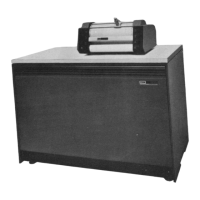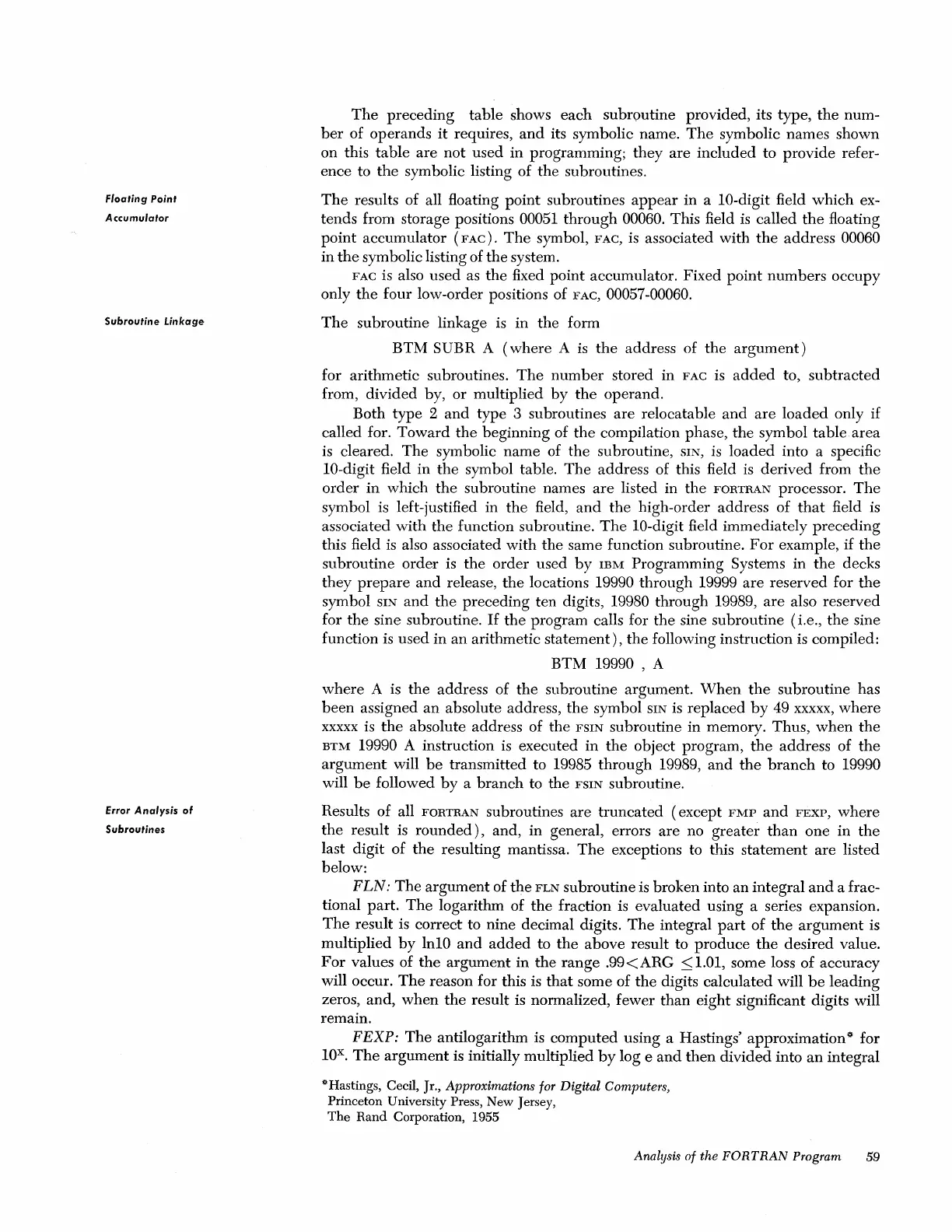Floating Point
Accumulator
Subroutine
Linkage
Error
Analysis
of
Subroutines
The
preceding
table
shows
each
subroutine provided, its type,
the
num-
ber
of operands
it
requires,
and
its symbolic name.
The
symbolic names shown
on this
table
are
not
used
in
programming;
they
are
included
to
provide
refer-
ence
to
the
symbolic listing of
the
subroutines.
The
results of all floating
point
subroutines
appear
in a 10-digit field
which
ex-
tends from storage positions
00051
through
00060. This field is called
the
floating
point
accumulator
(FAC).
The
symbol,
FAC,
is associated with
the
address 00060
in
the
symbolic listing of
the
system.
F
AC
is also
used
as
the
fixed point accumulator. Fixed
point
numbers
occupy
only
the
four low-order positions of
FAC,
00057-00060.
The
subroutine linkage is in
the
form
BTM
SUBR A
(where
A is
the
address of
the
argument)
for arithmetic subroutines.
The
number
stored in
FAC
is
added
to,
subtracted
from,
divided
by, or multiplied
by
the
operand.
Both
type
2
and
type 3 subroutines
are
relocatable
and
are
loaded
only
if
called for.
Toward
the
beginning of
the
compilation phase,
the
symbol
table
area
is
cleared.
The
symbolic
name
of
the
subroutine,
SIN,
is
loaded
into a specific
10-digit field in
the
symbol table.
The
address of this field is
derived
from
the
order
in
which
the
subroutine names
are
listed in
the
FORTRAN
processor.
The
symbol is left-justified in
the
field,
and
the
high-order address of
that
field is
associated
with
the
function subroutine.
The
10-digit field immediately
preceding
this field is also associated
with
the
same function subroutine.
For
example,
if
the
subroutine
order
is
the
order
used
by
IBM
Programming Systems in
the
decks
they
prepare
and
release,
the
locations 19990
through
19999
are
reserved for
the
symbol
SIN
and
the
preceding ten digits, 19980 through 19989,
are
also reserved
for
the
sine subroutine.
If
the
program calls for
the
sine subroutine (i.e.,
the
sine
function is
used
in
an arithmetic
statement),
the
following instruction is compiled:
BTM
19990 , A
where
A is
the
address of
the
subroutine argument.
When
the
subroutine has
been
assigned
an
absolute address,
the
symbol
SIN
is
replaced
by
49
xxxxx,
where
xxxxx
is
the
absolute address of the
FSIN
subroutine in memory. Thus,
when
the
BTM
19990 A instruction is executed in
the
object program,
the
address of
the
argument
will
be
transmitted to 19985
through
19989,
and
the
branch
to 19990
will
be
followed
by
a
branch
to the
FSIN
subroutine.
Results of all
FORTRAN
subroutines
are
truncated
(except
FMP
and
FEXP,
where
the
result is
rounded),
and,
in
general, errors
are
no
greater
than
one
in
the
last digit
of
the
resulting mantissa.
The
exceptions to this
statement
are
listed
below:
FLN:
The
argument
of
the
FLN
subroutine is broken into an integral
and
a frac-
tional
part.
The
logarithm of
the
fraction is evaluated using a series expansion.
The
result is correct to nine decimal digits.
The
integral
part
of
the
argument
is
multiplied
by
Inl0
and
added
to
the
above result
to
produce
the
desired value.
For
values of
the
argument
in
the
range
.99<ARG
.::::;
1.01, some loss of accuracy
will occur.
The
reason for this is
that
some of
the
digits calculated will
be
leading
zeros, and,
when
the
result is normalized, fewer
than
eight
significant digits will
remain.
FEXP:
The
antilogarithm is
computed
using a Hastings'
approximation~
for
lOX.
The
argument
is initially multiplied
by
log e
and
then
divided
into
an
integral
«Hastings, Cecil, Jr., Approximations for Digital Computers,
Princeton University Press, New Jersey,
The
Rand
Corporation, 1955
Analysis of the
FORTRAN
Program 59

